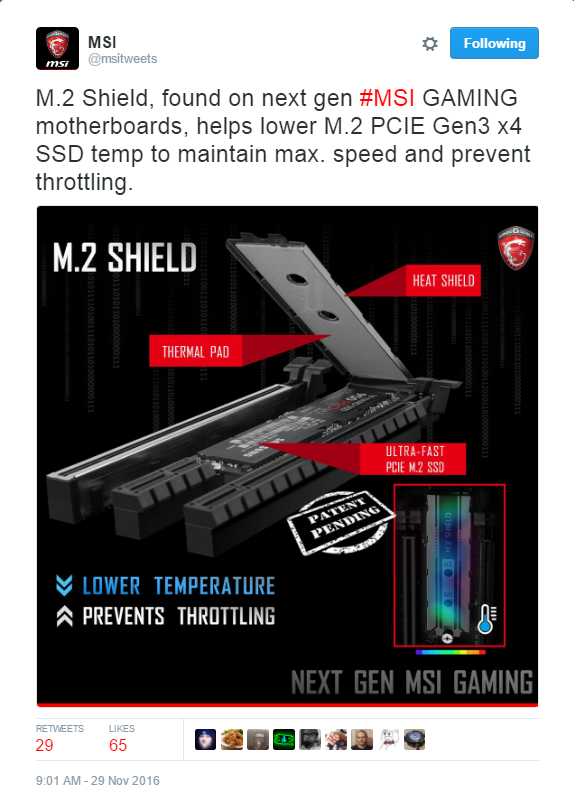MSI Plays Show And Tell With Motherboard M.2 Cooling Solution
MSI gaming motherboards built on the next generation 200-Series chipset platform will address thermal throttling issues on high-performance M.2 SSDs. MSI calls the included component "M.2 Shield," according to a tweet from the company today.
Motherboard surface space is limited with modern products and especially gaming-focused units. Many gamers and power users demand the latest technology. It's difficult to pack technology like Thunderbolt, ample USB, PCIe, U.2, and M.2 storage in such a constrained space. Most motherboard manufacturers have tucked the M.2 slots between PCIe slots, the only natural place where the 22 x 80mm devices fit nicely. The problem is that video cards, some generating up to 300 watts of heat output, sit in the PCIe slots and radiate that heat to the M.2 storage devices.
M.2 form factor NVMe SSDs have their own heat issues. The small circuit board sizes have less copper surface area than 2.5" form factor SSDs. The limited surface area means the controller heat spreads to the NAND flash, a component susceptible to increased degradation and wear from heat. SSD controllers can take up to (and even over) 100 degrees C in some cases, but only in short bursts. The components not designed for the high temperatures are the NAND flash and DRAM. SSD and flash processor designers built in safeguards that lower performance to decrease controller temperatures.
Until a few weeks ago, I would have doubted that a thin aluminum heatsink could make a dent in the temperature of a high-performance SSD. After testing the new Plextor M8Pe(G) M.2 SSD with a heatsink, though, it's become clear that a thin heatsink with a thick thermal transfer material pad can lower temperatures, but it still requires air flow to be effective.


In this chart from the Plextor M8Pe 1TB NVMe SSD review, you can see three M8Pe SSDs writing sequential data. The M8Pe(Y) uses a PCIe adapter bracket with a dense heatsink. The M8Pe(G) uses a thin aluminum heatsink like the one MSI showed in its November 29 tweet. The M8PeGN doesn't use a heatsink at all and shows thermal throttling conditions.
Amazon Pricing
| Header Cell - Column 0 | 128GB | 256GB | 512GB | 1TB |
|---|---|---|---|---|
| M8Pe(Y) AIC | $119.99 | $188.18 | $239.99 | $429.99 |
| M8Pe(G) M.2 Heatsink | $89.99 | $119.99 | $199.99 | $429.99 |
| M8PeGN M.2 Bare | $74.99 | $114.99 | $189.99 | $414.99 |
If you buy a new MSI gaming series motherboard with the heatsink, it means your next high-performance NVMe SSD could cost less. Because Plextor is the only company selling M.2 form factor products with a heatsink, it means other products may perform a little better under extended use.
Get Tom's Hardware's best news and in-depth reviews, straight to your inbox.

Chris Ramseyer was a senior contributing editor for Tom's Hardware. He tested and reviewed consumer storage.
-
RedJaron Others have, and have dealt with it in various ways. Gigabyte's X99 Designare has a similar system with the M.2 under an aluminum plate. Asus X99 RoG uses the extended ATX size to place it on the lead edge by the SATA ports, away from most GPU exhaust. ASRock sometimes places the M.2 above the PCIe slots. MSI just seems to want to make it somewhat standard on their boards.Reply -
mpdahaxing I'm glad I have a case whose side panel allows for a 3x3 array of 12cm fans. Blowing air directly onto the components and using deltas as exhaust to get the heat out.Reply -
Brian_R170 Unfortunately, it doesn't help dual-sided boards. Luckily, there aren't many dual-sided M.2 drives available, yet.Reply
Does anybody make a kit that includes a PCIe-to-M.2 adapter card and a stick-on heatsink that you can use with any M.2 SSD? I've seen these bundled with a specific M.2 SSD, but not sold as separate kits. -
RedJaron Don't think you'd need an additional heatsink if you put the M.2 on a PCIe card ( and yes, you can get those adapters ). This is more to shield the M.2 from the waste heat of the GPU, under which they normally sit. Put it on its own card and now the drive is inline with most front case fans so it should get a healthy dose of airflow.Reply -
JackNaylorPE It doesn't take much to cool most PC components ... as we saw with EVGA's VRMs on the 1070 / 1080 cards, chip temps can be drastically lowered rather simply. Adding a simple backplate to a GPU with proper TIM or thermal pad can do wonders for VRM temps. And like most other comparisons, what thermal pad and what heat sink material matters.Reply
But I do have one issue with related to questions unanswered. When I see an article entitled, "MSI Plays Show And Tell With Motherboard M.2 Cooling Solution" I expected to see the "show and tell part". Is a followup forthcoming where the Mister Miaggi "Heatsink On / Heatsink Off" test will be performed to show / tell us the results ? -
turkey3_scratch Reply18946747 said:because some of us own cooler master storm products such as scout v.2 with side panel vented window fan mounts or bottom case vented fan mount
http://www.coolermaster.com/case/mid-tower/scout-2/
I don't get it.
